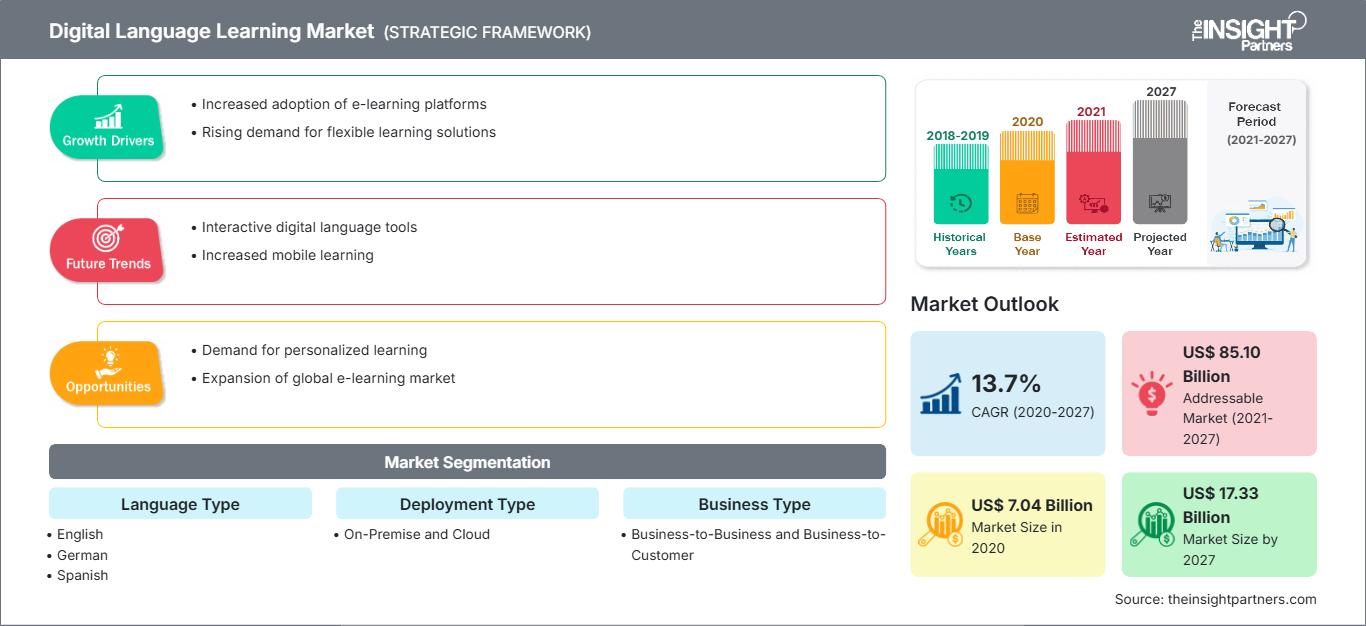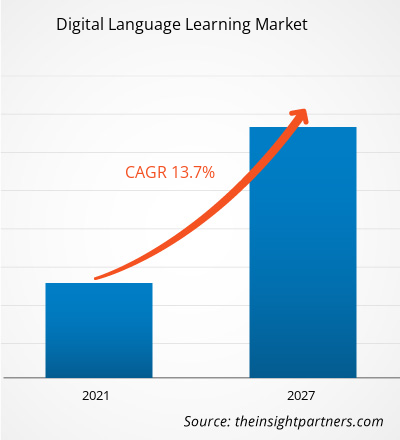Der Markt für digitales Sprachenlernen soll von 7.038,2 Millionen US-Dollar im Jahr 2020 auf 17.333,4 Millionen US-Dollar im Jahr 2027 wachsen; von 2020 bis 2027 wird mit einer durchschnittlichen jährlichen Wachstumsrate von 13,7 % gerechnet.
Initiativen verschiedener Regierungen zur Einführung von Englischlernprogrammen tragen zum Marktwachstum bei. Der globale Bildungssektor verändert sich aufgrund verschiedener Initiativen von Regierungen und privaten Organisationen zur Bereitstellung digital verbesserter Leistungen exponentiell. Regierungen verschiedener Länder wie China, Australien, Brasilien und die Vereinigten Arabischen Emirate haben in den vergangenen Jahren digitale Bildungsprogramme initiiert, die diesen Ländern geholfen haben, ihre Englischunterrichtssysteme zu verbessern. So hat beispielsweise die vor einem Jahrzehnt von der australischen Regierung initiierte Digital Education Revolution (DER) mehreren Schulen und Universitäten ermöglicht, digitale Bildung zu nutzen. Die chinesische Regierung hat verschiedene Maßnahmen zur Förderung der digitalen Bildung mit Schwerpunkt auf dem Englischlernen ergriffen. Dies hat die Zahl der Unternehmen, die chinesische Studierende mit digitalen Lernlösungen versorgen, stark erhöht. 51Talk ist eine der bekanntesten digitalen Einrichtungen für Englischunterricht in China. 17Zuoye ist eine weitere digitale Plattform für chinesische Studierende, Lehrkräfte und Eltern, die Online-Aufgaben in Form von Übungen und Hausaufgaben bereitstellt, damit Nutzer ihre Fähigkeiten verbessern können. Indien arbeitet derzeit intensiv daran, einen großen Markt für digitale Bildung zu schaffen. Die indische Regierung hat verschiedene Initiativen ergriffen, um Digitalisierungstechnologien im Bildungssektor zu etablieren. SWAYAM ist die bekannteste digitale Lernplattform und Initiative der indischen Regierung. Sie unterstützt Studierende bei der Auswahl von Online-Kursen in allen Bereichen der Hochschulbildung. Auch internationale Universitäten können ihre Kurse und Prüfungen über die SWAYAM-Plattform anbieten. Dies erleichtert Studierenden das Lernen und die Teilnahme an Prüfungen an internationalen Universitäten. Dies verbessert die Englischkenntnisse der Studierenden in Wort und Schrift. Die nationale digitale Bibliothek ist eine weitere Initiative der indischen Regierung mit dem Ziel, virtuelle Lernressourcen aus einer Hand anzubieten. Diese Initiative gewinnt zunehmend an Bedeutung und dürfte den Markt für digitales Englischlernen in Indien in den kommenden Jahren ankurbeln und so zum Wachstum des globalen Marktes für digitales Sprachenlernen beitragen.
Passen Sie diesen Bericht Ihren Anforderungen an
Sie erhalten kostenlos Anpassungen an jedem Bericht, einschließlich Teilen dieses Berichts oder einer Analyse auf Länderebene, eines Excel-Datenpakets sowie tolle Angebote und Rabatte für Start-ups und Universitäten.
Markt für digitales Sprachenlernen: Strategische Einblicke

-
Holen Sie sich die wichtigsten Markttrends aus diesem Bericht.Dieses KOSTENLOSE Beispiel umfasst Datenanalysen, die von Markttrends bis hin zu Schätzungen und Prognosen reichen.
Der jüngste Ausbruch der Pandemie hat in den letzten Monaten weltweit zu erheblichen positiven Umbrüchen im bestehenden Bildungssektor geführt. Darüber hinaus führten die Umbrüche in den konventionellen Bildungseinrichtungen und bei klassenzimmerbasierten Lernmethoden zu einem sprunghaften Anstieg der Nutzung robuster und effizienter Online- und digitaler Lernlösungen. Es wird erwartet, dass dies das Marktwachstum auch nach der Pandemie in den kommenden Jahren weiter vorantreiben wird. So haben beispielsweise die UNESCO, mehrere führende Vertreter von Technologieunternehmen und der ITU (Internationale Fernmeldeunion) zusammengearbeitet, um die wirtschaftliche Bedeutung der Nutzung digitaler Technologien im Bildungsbereich hervorzuheben, um einem breiten Publikum schnelle Lernfähigkeiten ohne erhebliche Investitionen in physische Infrastrukturen in den Schwellenländern zu ermöglichen. In einer separaten Umfrage der Universität Cambridge gaben über 1.200 Teilnehmer an, dass 60 % der Befragten in den kommenden Jahren eine erhöhte Neigung haben, bei digitalen Lerntechnologien zu bleiben. Daher hat der jüngste Ausbruch zu einem starken Anstieg der Nutzung digitaler Lerntechnologien geführt und sich in der Folge positiv auf das Marktwachstum der letzten Monate ausgewirkt.
Markteinblicke – Markt für digitales Sprachenlernen: Nutzung fortschrittlicher und vereinfachter Technologien, um Schüler für digitale Bildung zu begeistern
In Industrieländern wie den USA und Großbritannien erfreut sich das digitale Bildungssystem enormer Beliebtheit, da die Schüler an Schulen, Universitäten und anderen Einrichtungen mit den Technologien bestens vertraut sind. In den Ländern Asien-Pazifik und Südamerika (SAM) ist den Schülern das technologiegestützte Lernen jedoch nicht bewusst. Zahlreiche Schulen, Universitäten und Nachhilfeinstitute setzen in ihrem Unterricht digitale Technologien ein. Während die Entwickler digitaler Bildungsplattformen ihre Technologien ständig verbessern, um robuste Lösungen anzubieten, modernisieren die Anwender in der Region Asien-Pazifik kontinuierlich ihre Technologieinfrastruktur. Es wird erwartet, dass die innovativen cloudbasierten Bildungs-Apps, Websites und anderen Dienste einen bedeutenden Markt für digitale Bildung schaffen werden, einschließlich digitaler Sprachlernlösungen.
Sprachtypbasierte Erkenntnisse
Basierend auf dem Sprachtyp ist der Markt für digitales Sprachlernen in Englisch, Mandarin, Spanisch, Deutsch und andere Sprachen segmentiert. Das englische Segment hatte 2019 den größten Marktanteil.Digitales Sprachlernen
Regionale Einblicke in den Markt für digitales SprachenlernenDie Analysten von The Insight Partners haben die regionalen Trends und Faktoren, die den Markt für digitales Sprachenlernen im Prognosezeitraum beeinflussen, ausführlich erläutert. In diesem Abschnitt werden auch die Marktsegmente und die geografische Lage in Nordamerika, Europa, dem asiatisch-pazifischen Raum, dem Nahen Osten und Afrika sowie Süd- und Mittelamerika erörtert.
Umfang des Marktberichts zum digitalen Sprachenlernen
| Berichtsattribut | Einzelheiten |
|---|---|
| Marktgröße in 2020 | US$ 7.04 Billion |
| Marktgröße nach 2027 | US$ 17.33 Billion |
| Globale CAGR (2020 - 2027) | 13.7% |
| Historische Daten | 2018-2019 |
| Prognosezeitraum | 2021-2027 |
| Abgedeckte Segmente |
By Sprachtyp
|
| Abgedeckte Regionen und Länder |
Nordamerika
|
| Marktführer und wichtige Unternehmensprofile |
|
Dichte der Marktteilnehmer im Bereich digitales Sprachenlernen: Die Auswirkungen auf die Geschäftsdynamik verstehen
Der Markt für digitales Sprachenlernen wächst rasant. Die steigende Nachfrage der Endnutzer ist auf Faktoren wie veränderte Verbraucherpräferenzen, technologische Fortschritte und ein stärkeres Bewusstsein für die Produktvorteile zurückzuführen. Mit der steigenden Nachfrage erweitern Unternehmen ihr Angebot, entwickeln Innovationen, um den Bedürfnissen der Verbraucher gerecht zu werden, und nutzen neue Trends, was das Marktwachstum weiter ankurbelt.

- Holen Sie sich die Markt für digitales Sprachenlernen Übersicht der wichtigsten Akteure
Akteure auf dem Markt für digitales Sprachenlernen konzentrieren sich hauptsächlich auf die Entwicklung fortschrittlicher und effizienter Produkte.
- 2019 kündigte Fluenz die Ausweitung seines spanischen Luxus-Immersionsprogramms auf Barcelona, Spanien, im Frühjahr 2020 an. Die Benutzer könnten für sechs Tage an dem Programm teilnehmen, um Sprachen zu lernen.
- 2018 kündigte Preply, Inc. seine Pläne an, Anfang 2019 ein neues Büro in Barcelona zu eröffnen. Die Expansion war das Ergebnis einer Finanzierung in Höhe von 4 Millionen US-Dollar im Juli. Das Unternehmen plant außerdem, seine Präsenz auf den deutschen, britischen, amerikanischen und lateinamerikanischen Märkten auszubauen.
Der Markt für digitales Sprachenlernen wurde wie folgt segmentiert:
Globaler Markt für digitales Sprachenlernen – nach Sprachtyp
- Englisch
- Deutsch
- Spanisch
- Mandarin
- Sonstige
Globaler Markt für digitales Sprachenlernen – nach Bereitstellungstyp
- On-Premises
- Cloud
Globaler Markt für digitales Sprachenlernen – nach Geschäftstyp
- Business-to-Business
- Business-to-Customer
Globaler Markt für digitales Sprachenlernen – nach Endbenutzer
- Akademiker
- Nicht-Akademiker
Globaler Markt für digitales Sprachenlernen – nach Geografie
- Nordamerika
- USA
- Kanada
- Mexiko
- Europa
- Frankreich
- Deutschland
- Italien
- Russland
- Vereinigtes Königreich
- Übriges Europa
- Asien-Pazifik (APAC)
- Japan
- China
- Australien
- Indien
- Südkorea
- Rest von APAC
- Naher Osten und Afrika (MEA)
- Saudi-Arabien
- VAE
- Südafrika
- Rest von MEA
- Südamerika (SAM)
- Brasilien
- Argentinien
- Rest von SAM
Markt für digitales Sprachenlernen – Firmenprofile
- Babbel
- Busuu, Ltd.
- Fluenz
- Lingoda GmbH
- Living Language (Penguin Random House, LLC)
- Pearson PLC
- Preply, Inc.
- Rosetta Stone, Inc.
- Verbling, Inc.
- Yabla, Inc.
- Historische Analyse (2 Jahre), Basisjahr, Prognose (7 Jahre) mit CAGR
- PEST- und SWOT-Analyse
- Marktgröße Wert/Volumen – Global, Regional, Land
- Branchen- und Wettbewerbslandschaft
- Excel-Datensatz
Aktuelle Berichte
Verwandte Berichte
Erfahrungsberichte
Grund zum Kauf
- Fundierte Entscheidungsfindung
- Marktdynamik verstehen
- Wettbewerbsanalyse
- Kundeneinblicke
- Marktprognosen
- Risikominimierung
- Strategische Planung
- Investitionsbegründung
- Identifizierung neuer Märkte
- Verbesserung von Marketingstrategien
- Steigerung der Betriebseffizienz
- Anpassung an regulatorische Trends






















 Kostenlose Probe anfordern für - Markt für digitales Sprachenlernen
Kostenlose Probe anfordern für - Markt für digitales Sprachenlernen